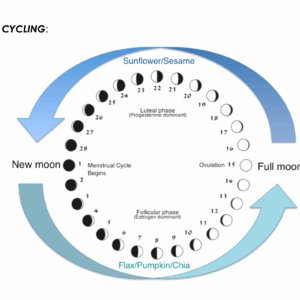Treating Infertility: A Whole-Body Approach Including Mayan Uterine Massage & Seed Cycling
ANA LARA, NMD
Fertility is a topic that many women have strong personal feelings about. I often hear my female patients say, “Having children is the one thing I am designed to do, yet I can’t get pregnant. I feel less of a woman.” Well, let me start off by stating the obvious that women were designed to do more than have babies. Yet, I also take a woman’s fertility concerns seriously. As physicians, we must test and not guess. I like to work with both partners who are trying to conceive, as it makes the most sense to screen both of them for medical conditions as part of an overall health assessment. We check sex hormones, thyroid function, and vitamin D levels, and we screen for diabetes, polycystic ovary syndrome, endometriosis, and autoimmune conditions that are known to cause fertility issues, such as lupus or Hashimoto’s thyroiditis. Sometimes genetic testing is useful, especially if the couple has no medical conditions and they’re failing to conceive despite natural and/or conventional interventions.
I also check for a history of sexual or physical trauma that might be causing a stress response in the body that is preventing conception. This applies to men too; we cannot turn our heads the opposite direction when it comes to treating male patients and their mental/emotional state. Generally, men are often not used to discussing these topics or correlating their mental health with fertility.
In male patients, it is important to determine any history of physical problems involving their testicles, and to check for blockages in the ducts that carry sperm, hormone imbalances, a history of mumps, and genetic disorders. Take a look at their lifestyle and rule out environmental exposures, low sperm count or low-quality sperm, and any medical conditions that could affect the quality of sperm or hormone levels. In my practice, it’s not uncommon to see young men in their 20s who have low testosterone, elevated estrogen, and/or undiagnosed diabetes or hypertension; all of these can affect male fertility. It is imperative to treat the couple when it comes to fertility concerns. According to MedlinePlus, about one-third of the time a couple’s infertility is due to a problem with the man, one-third of the time it’s due to a problem with the woman, and one-third of the time the problem relates to both male and female issues or it cannot be identified.1,2
For some of those couples who decide they want to have a baby, it’s an effortless act to conceive. For others, though, it can be mentally, emotionally, and financially exhausting when they don’t achieve the end result of a pregnancy. According to the Centers for Disease Control and Prevention (CDC), among US women aged 15-49, 13.1% have impaired fecundity (ie, lack the potential to produce children); 16.2% of married women have impaired fecundity; 8.8% of married women are infertile (ie, do not produce children); and 12.7% of women have used infertility services.3
The Therapeutic Order
The Therapeutic Order is a set of guidelines used in naturopathic medicine to help the physician resolve the patient’s symptoms and address the underlying causes using the least invasive therapies.4 I will share how I personally approach fertility and endocrinology cases while using this approach.
Identify Determinants of Health
First of all, I identify and remove any factors that could be causing imbalances, and make the necessary corrections. Once I have identified potential obstacles to cure and removed them, I support the patient’s body with the essentials it needs. Obstacles to cure can include:
- Imbalanced nutrition and/or hydration
- Poor sleep habits
- Stress (emotional, chemical, physical)
- Environmental factors (eg, products containing toxic chemicals, BPA-containing products, alcohol, or smoking)
- Certain medications and/or history of birth control
- Imbalances revealed by blood tests
Stimulate Self-Healing
How does one stimulate self-healing when it comes to dealing with fertility concerns? The following is where I like to start, and I recommend that both male and female partners give themselves 6 months to work on this, and no less than 3 months.
- A nutritionally balanced diet: This includes plenty of protein, healthy fats, and healthy complex carbs, as these are building blocks for a healthy and optimal foundation. Once we clean up the diet, I recommend a detox to ensure optimal digestion and absorption of nutrients.
- Detoxification: I often have patients take a proprietary herbal blend that aids in detoxification of the lungs, skin, kidneys, liver, and digestion. Ingredients include: Scrophularia nodosa, Arctium lappa (root), Galium aparine (aerial parts), Smilax officinalis (root), Taraxacum officinale (root), Rumex crispus (root), Trifolium pratense (flower), Urtica dioica (leaf), and Ziziphus jujuba (fruit). I have the patient take this tincture for 2 weeks, 2 droppersful 4 times per day. Once they finish this 2-week detox, I have them proceed with another proprietary herbal blend for 4 weeks to tonify the liver (using the same dosing as the other tincture). Ingredients in this formula include: Silybum marianum (seed), Arctium lappa (root), Taraxacum officinale (root), Bupleurum falcatum (root), Chelidonium majus (whole plant), Chionanthus virginica (bark of root), Glycyrrhiza glabra (root), Mahonia aquifolium (root), Rumex crispus (root), and Schisandra chinensis (fruit). I have both male and female patients take these products if they are trying to conceive.
- Quality sleep and consistent sleep patterns: Eight hours of sleep per night is preferred. Many pregnant women complain about being tired and wanting to sleep. This is something I often have to educate women about: It is okay to sleep! Pregnancy is a time to slow down because the body is building a human, and that requires a lot of energy. They will need to sleep during pregnancy, as well as post-partum. Good luck trying to catch up on sleep when you have a baby! Women need to sleep more. This is the perfect time to educate the patient on the importance on sleep and establishing additional healthy habits. Much healing and regeneration happens during sleep, so getting that deep and restful sleep is key. We discuss sleep hygiene for the bedroom; if quality of sleep is also an issue, we might also address targeted supplementation.
- Physical movement: Getting physical activity that involves the pelvic region, legs, glutes, and core muscles is very important. This will encourage blood and lymphatic flow to the pelvic region. Doing squats, lunges, pelvic tilts, and working the inner and outer thighs are all helpful in this regard. Don’t be surprised if the patient’s libido increases. Energetically, it’s where the root chakra and sacral chakras are located, and it’s the source of our vital energy. This energy plays a huge role in fertility. Get those hips and legs working!
- Prayer, meditation, and breathing exercises: I teach my patients several breathing techniques, such as pranic breathing 6-3-6-3 (inhale for 6 counts, hold for 3, exhale for 6, rest for 3) or the “box breathing” technique (4 counts each for inhale, hold, exhale, and rest). I also encourage my patients to find a practice of meditation and/or prayer that feels comfortable to them. I disclose that I am not trying to convince them of any particular belief; however, I encourage them to seek what that means to them. Bringing life into this world is a far cry from buying a fancy pair of shoes; it should require some soul searching. One should think about their desire to create and birth life: Why is having a child, meaningful to them? We are quick to throw supplements and invasive fertility treatments at patients, but rarely have an honest conversation with them about why getting pregnant even matters to them. We live in a society where instant gratification and feelings of entitlement are so prevalent that we neglect to explore the deep meaning of creating life. This also helps those patients who may never be able to conceive a child – to find healing in their experience and grow from it, all while acquiring some coping techniques. These same techniques can also help reduce stress, which is very much needed in our lives.
- Supplementation: I make sure that women who are trying to conceive are on a good prenatal multi-vitamin, omega-3 fatty acids, a probiotic, and N-acetylcysteine (NAC). Depending on a patient’s medical conditions, I tailor the supplements to address those imbalances. I make sure to check vitamin D levels, as studies have shown the importance of vitamin D in fertility.5 Studies have been conducted on the effectiveness of oral NAC in improving sperm parameters and oxidative/antioxidant status in infertile males.6 I typically dose NAC at 600 mg per day for both males and females.
Aid Damaged Organs
Addressing weakened or damaged systems or organs can involve many different factors when it comes to fertility.
- Immune system: I evaluate whether a patient has any autoimmune condition that could cause infertility, such as lupus, Hashimoto’s thyroiditis, Grave’s disease, etc. This involves checking for auto-antibodies and then addressing the imbalance. Otherwise, the patient could miscarry – an additional emotional, mental, and physical stressor. I focus on modulating immunity and decreasing excess inflammation.
- Decrease toxicity: I examine the patient’s diet, personal hygiene products, and/or other household products that could be causing an endocrine disruption. Once I identify disruptors, I educate the patient and have them remove them ASAP. Sometimes a detox is a great way for the patient to start on a new health and wellness regimen.
Correct Structural Integrity
Physical techniques I might incorporate into a patient’s care include: Physical manipulation, muscle testing, craniosacral therapy, acupuncture, and Mayan abdominal massage. This last technique deserves a detailed discussion.
Mayan Abdominal/Uterine Massage
This ancient massage technique has been passed down from many generations. I had the pleasant experience of learning it from naturopathic physicians as well as from Mayan healers in Belize. Mayan abdominal and uterine massage is an external massage performed in cases of dysmenorrhea, amenorrhea, infertility, constipation and other GI issues, and for mental and emotional health. Mayan culture believes that if the woman is happy, the uterus is happy, and vice versa. “La sobada,” which translates to “massage” in Spanish, is how women in Latino culture refer to it. The technique is commonly used in both adults and children for various ailments.
Mayan abdominal/uterine massage, specifically, begins with prayer and setting intention for both the patient and the practitioner. It works on releasing fascia and increasing circulation in the abdominal area, as well as evaluating the position of the uterus.
This therapy is performed weekly, and I do a series of 3 or 6 sessions, depending on each patient’s findings. Each session is about 45 minutes to an hour. The patient lies down and relaxes while I focus on doing release work in the upper and lower abdomen; I also do acupressure massage on the lower extremities. The technique I use is gentle, and I build on the pressure according to what I feel in the patient’s body. It is not unusual for patients to release some pent-up emotions during the procedure. Women report feeling better mentally, improvements in their menstrual cycle, increased libido, better bowel movements, more vitality, and they often don’t realize how much stress they had in their abdominal area. By improving blood and lymph flow to the pelvic region, women increase their chances of pregnancy.
Seed Lunar Cycling
I employ food as medicine, and there is no better way to support a woman’s menstrual cycle than putting them on a seed lunar cycling regimen. This is a great way to encourage fertility using oils and seeds that promote a healthy balance of estrogen and progesterone. It often takes several months for women’s menstrual cycles to sync with the lunar cycle. During the pandemic, many of my female patients’ cycles have been irregular due to stress. Women always report feeling better after following this regimen. I also have them do sleep hygiene (including sleeping in complete darkness and avoiding electronics, etc), and I encourage them to get exposure to sunlight first thing in the morning. See Table 1 for the details of what I recommend to my patients during the different lunar phases.

| Day 1 – 14 | Day 15 – 28 | |
| Lunar Phase | New Moon à Full Moon | Full Moon à New Moon |
| Seeds | 1-2 tbsp ground Flax/Pumpkin/Chia seeds per day | 1-2 tbsp ground Sesame/Sunflower seeds per day |
| Essential Fatty Acids (EFA) | 2-3 g Fish Oil per day (Omega-3) | 1-2 g Fish Oil + 1 g Evening Primrose Oil/Borage Oil (Omega-6) |
| Why? | This seed/EFA combination supports the estrogen-dominant part of the cycle. EPA is anti-inflammatory and decreases pain. It also keeps cell walls healthy. | This seed/EFA combination supports the progesterone peaks in the cycle. GLA is found in EPO/BO. It is anti-inflammatory and helps treat PMS/menstrual disorders. |
Conclusion
The conversation on fertility should be happening at a much earlier age for both women and men, as this allows for proper education and awareness of the factors that affect not just fertility, but the overall endocrine system as well. For those seeking assistance with fertility using a natural and whole-person approach, the methods discussed in this article are the least invasive and good places to start. Patients can then work their way up from there. Again, always treat the couple; you need a healthy man and a healthy woman to create a healthy baby.
References:
- MedlinePlus. Male Infertility. Available at: https://medlineplus.gov/maleinfertility.html. Last updated August 27, 2020. Accessed November 25, 2020.
- National Institute of Child Health and Human Development. How common is male infertility, and what are its causes? Last reviewed December 1, 2016. NICHD Web site. https://www.nichd.nih.gov/health/topics/menshealth/conditioninfo/infertility. Accessed November 25, 2020.
- Centers for Disease Control and Prevention. National Center for Health Statistics. Infertility. Last reviewed December 2, 2019. CDC Web site. https://www.cdc.gov/nchs/fastats/infertility.htm. Accessed November 25, 2020.
- Association of Accredited Naturopathic Medical Colleges. The Therapeutic Order of Naturopathic Medicine. August 6, 2019. AANMC Web site. https://aanmc.org/featured-articles/therapeutic-order/. Accessed November 25, 2020.
- Pilz S, Zittermann A, Obeid R, et al. The Role of Vitamin D in Fertility and during Pregnancy and Lactation: A Review of Clinical Data. Int J Environ Res Public Health. 2018;15(10):2241.
- Jannatifar R, Parivar K, Roodbari NH, Nasr-Esfahani MH. Effects of N-acetyl-cysteine supplementation on sperm quality, chromatin integrity and level of oxidative stress in infertile men. Reprod Biol Endocrinol. 2019;17(1):24.

Ana Lara, NMD is a licensed naturopathic physician and the owner of Raices Naturopathic Medical Center, PLLC, in Phoenix, AZ. She earned her doctorate in Naturopathic Medicine from SCNM. Dr Lara’s practice focus includes family medicine, pediatrics, women’s health, endocrine disorders, pain management, neurological disorders, and autoimmune diseases. She is also an expert in preventing and treating type II diabetes and thyroid disorders. Dr Lara knows first-hand what chronic disease can do to one’s quality of life, which is why she is passionate about disease prevention and reversing disease. Dr Lara uses the most effective natural treatments in conjunction with the latest medical research.









